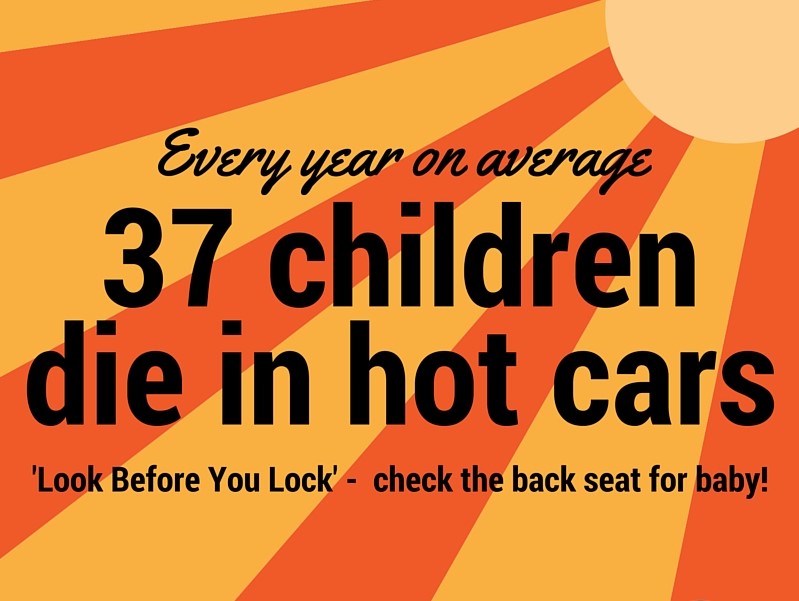The National Safety Council has released a groundbreaking report on pediatric vehicular heatstroke (PVH) titled, Kids in Hot Cars; a Legislative Look Across the U.S.
On average, 37 children die each year due to PVH; 42 children died during 2017, alone. All of these deaths were preventable.
In an effort to better understand and document this risk, NSC works with partner experts, including Jan Null, a certified consulting meteorologist and adjunct professor at San Jose State University. Mr. Null has been tracking child deaths resulting from vehicular heatstroke since 1998, and his work provides the basis for data and information in this report.
The objective of the report is to:
- Support stronger laws to protect children from being knowingly left unattended in vehicles
- Increase awareness and understanding of vehicle heating dynamics
- Increase awareness of the risk of children gaining access to vehicles on their own
- Encourage policies for childcare providers
- Recommend study of factors that contribute to unknowingly leaving a child in a vehicle
The report also features a first-hand account of a father who lost his beloved daughter.
Dozens of children die needlessly this way every year, and it can happen to anyone. Please read and share this life-saving information.
Download the Kids in Hot Cars Report (pdf)
Download Heatstroke Safety Tips (pdf)

Children, Pets and Vehicles
It is NEVER safe to leave a toddler, disabled person or pet locked in a car. Even in the winter. So far in 2018, one toddler has died due to heat. That death occured in February! Cars can heat up quickly when left in the sun. North American summers are hot. Sometimes spring and fall temperatures reach dangerous levels as well. Most summers see heat waves in one or more parts of the United States. Heat is one of the leading weather-related killers in the United States, resulting in hundreds of fatalities each year and even more heat-related illnesses. In addition to the resources below,
–Never leave children, disabled adults or pets in parked vehicles!
Each year, dozens of children and untold numbers of pets left in parked vehicles die from hyperthermia, which occurs when the body absorbs more heat than it can handle. Hyperthermia can occur even on a mild day with temperatures in the 70s. Studies have shown that the temperature inside a parked vehicle can rapidly rise to a dangerous level for children, pets and even adults. Leaving the windows slightly open does not significantly decrease the heating rate. The younger the child the more severe the effects because their bodies have not developed the ability to efficiently regulate its internal temperature. Get free downloadable flyers, banner on infant and toddler car safety.
–How fast can the sun heat a car?
The sun’s shortwave radiation (yellow in figure below) heats objects that it strikes. For example, a dark dashboard or seat can easily reach temperatures in the range of 180 to over 200°F. These objects (e.g., dashboard, steering wheel, child seat) heat the adjacent air by conduction and convection and also give off longwave radiation (red in figure below) which is very efficient at warming the air trapped inside a vehicle. Shown below are time lapse photos of thermometer readings in a car over a period of less than an hour. As the animation shows, in just over 2 minutes the car went from a safe temperature to an unsafe temperature of 94.3°F. This demonstration shows just how quickly a vehicle can become a death trap for a child
–Heat Stroke
Hyperthermia deaths aren’t confined to summer months. They also happen during the spring and fall. Below are just a few of MANY tragedies.
North Augusta, SC, April: A mother left her a 15-month-old son in a car. He was in a car for 9 hours while his mom went to work. She is now serving a 20-year prison sentence.
Honolulu, HI, March: A 3-year-old girl died when the father left her in a child seat for 1.5 hours while he visited friends in a Waikiki apartment building. The outside temperature was only 81 degrees.
Greenville, TX, December: A 6-month-old boy died after being left in a car for more than 2 hours by his mother. She was charged with murder. The temperature rose to 81 degrees on that day.
Adults also are susceptible to hyperthermia in vehicles. On July 12, 2001, a man died of heat stroke after falling asleep in his car with the windows rolled up in the parking lot of a supermarket in Hinds County, MS.
Heatstroke deaths of children in vehicles
On average, 37 children under the age of 15 die each year from heatstroke after being left in a vehicle. Nearly every state has experienced at least one death since 1998, and in 2017, 42 children died after being left in a hot vehicle. The number of child heatstroke deaths for 2018 will be updated as new information becomes available throughout the year. The data provided on this page is made available by Jan Null, CCM, Department of Meteorology and Climate Science, San Jose State University. Null, a certified consulting meteorologist, has been tracking U.S. child vehicular heatstroke deaths since 1998. His research indicates that in more than half of these fatalities, the child was forgotten in the vehicle by a parent or caregiver.
Download Report Not-in-Traffic Surveillance: Non-Crash Fatalities and Injuries (pdf)
Child heatstroke deaths in vehicles Charts and Tables (webpage)

For additional information please visit noheatstroke.org
Explore the data details to track trends by state, outside air temperature and sex of victim.



